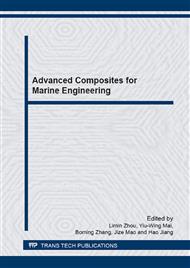p.273
p.278
p.285
p.293
p.300
p.307
p.315
p.323
p.337
Investigation of Controllable Parameters of Mechanical Treatment on Aluminum-Based Composite in Marine Application
Abstract:
Surface Mechanical Attrition Treatment (SMAT) process, as one of the typical severe plastic deformation technologies, can be utilized to generate layup structure with finer size of grains and large residual stresses at the near treated surface area on the alloys. Such technology not only improves the mechanical behaviors but also keeps neatness of alloys without inducing extra compositions. In this paper, four major controllable parameters of SMAT process are investigated to demonstrate their influence on ball-impacting intensity of the treatment, which the improvement of mechanical behaviors are greatly dependent on. The high speed camera is employed to capture the motion of the balls and measure the impact velocities by counting the number of frames. The compared results indicate that the amount of balls not only varies the average velocities during SMAT process, but also offsets the effect of distance between treated surface and source of balls. In addition, the influence of ball sizes, the mentioned distance and power of excitation exhibits apparently on intensity of SMAT process when limited amount of balls are used.
Info:
Periodical:
Pages:
307-314
Citation:
Online since:
March 2015
Authors:
Price:
Сopyright:
© 2015 Trans Tech Publications Ltd. All Rights Reserved
Share:
Citation:


